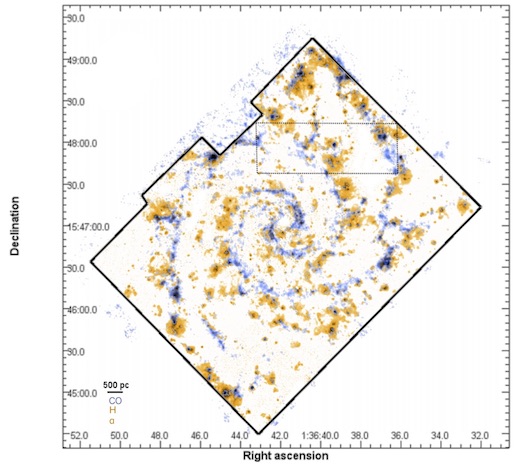Star formation is a multi-scale process that requires tracing cloud formation and stellar feedback within the local (≲kpc) and global galaxy environment. We present first results from two large observing programs on the Atacama Large Millimeter/submillimeter Array (ALMA)and the Very Large Telescope/Multi Unit Spectroscopic Explorer(VLT/MUSE), mapping cloud scales (1″ = 47 pc) in both molecular gas and star-forming tracers across 90 kpc2 of the central disk of NGC 628 to probe the physics of star formation. Systematic spatial offsets between molecular clouds and H II regions illustrate the time evolution of star-forming regions. Using uniform sampling of both maps on 50-500 pc scales, we infer molecular gas depletion times of 1-3 Gyr, but also find that the increase of scatter in the star formation relation on small scales is consistent with gas and H II regions being only weakly correlated at the cloud (50 pc) scale. This implies a short overlap phase for molecular clouds and H II regions, which we test by directly matching our catalog of 1502 H II regions and 738 GMCs. We uncover only 74 objects in the overlap phase, and we find depletion times >1 Gyr, significantly longer than previously reported for individual star-forming clouds in the Milky Way. Finally, we find no clear trends that relate variations in the depletion time observed on 500 pc scales to physical drivers (metallicity, molecular and stellar-mass surface density, molecular gas boundedness) on 50 pc scales. (As it appears in paper).
Kreckel, K.; Faesi, C.; Kruijssen, J. M. D.; Schruba, A.; Groves, B.; Leroy, A. K.; Bigiel, F.; Blanc, G. A.; Chevance, M.; Herrera, C.; Hughes, A.; McElroy, R.; Pety, J.; Querejeta, M.; Rosolowsky, E.; Schinnerer, E.; Sun, J.; Usero, A.; Utomo, D.
2018, The Astrophysical Journal Letters, 863, L21
http://adsabs.harvard.edu/abs/2018ApJ…863L..21K
